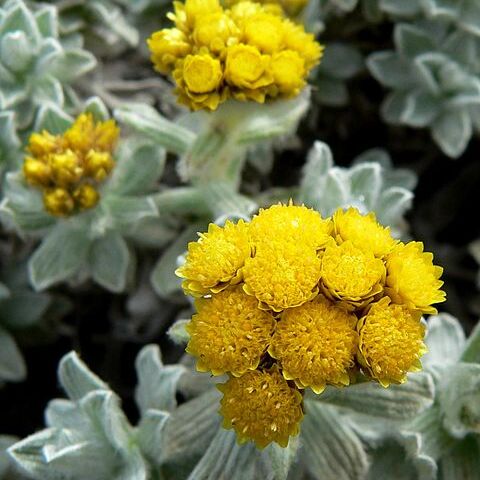Virgate shrub up to 1.5 m tall, or rarely sprawling, branches thinly grey-woolly, closely leafy, older parts glabrescent, rough with leaf scars. Leaves 10-30(-40) x 1-2(-6) mm, linear, linear-oblong or linear-lanceolate, apex acute or subacute, mucronate, base broad, half-clasping, margins commonly revolute, upper surface thickly or thinly greyish-white woolly or glabrous or nearly so, lower surface greyish-white woolly. Heads heterogamous, hemispherical, 4-5 mm long, 5-8 mm across the radiating bracts, bases woolly, many in congested or open corymbose panicles terminating long leafy branches. Involucral bracts in ±5 series, graded, loosely imbricate, inner about equalling or slightly exceeding flowers, tips minutely radiating, bright canary-yellow, rarely orange, glossy. Receptacle very shortly honeycombed. Flowers 47-105, 8-14 female, 39-84 homogamous, yellow. Achenes 0.75 mm long, with duplex hairs. Pappus bristles many, equalling corolla, scabrid, bases cohering by patent cilia.
Shrub, up to 1.5 m high; virgate, rarely sprawling; branches thinly grey-woolly, closely leafy. Leaves: blade linear, linear-oblong or linear-obovate, 10-30(-40) x 1-2(-6) mm, apex acute or subacute, mucronate, base broad, half-clasping, margins revolute; upper surface thickly or thinly greyish white-woolly or glabrous, lower surface greyish white-woolly. Heads disciform, hemispherical, 4-5 x 5-8 mm, many in congested or open, corymbose panicles, terminal. Involucral bracts in ± 5 series, graded, loosely imbricate, inner ± equalling or slightly exceeding florets, bright canary-yellow, rarely orange, glossy, tips minutely radiating, stereome divided. Receptacle epaleate, shortly honeycombed. Flowers: female and disc florets 47105, 8-14 female; corolla of disc florets narrowly campanulate above, yellow; Oct.-Jan. Fruit with cypsela hairy. Pappus of many barbellate bristles, bases cohering by patent cilia.
Virgate shrub, up to 1.5 m high, rarely sprawling. Branches thinly grey-woolly, closely leafy, older parts glabrescent, rough with leaf scars. Leaves 10-40 x 1-6 mm, linear to linear-lanceolate, base broad, ± clasping, margins revolute, upper surface greyish white-woolly or ± glabrous, lower surface greyish white-woolly. Capitula hemispherical, 2-5 mm long; involucral bracts in 5 series, bright yellow, rarely orange, glossy. Flowers 47-105, yellow. Flowering time Oct.-Jan. Pappus of many bristles. Cypselae 0.75 mm long.
Virgate shrub, up to 1.5 m high. Leaves 10-30(-40) x 1-2(-6) mm, linear, linear-oblong or linear-lanceolate, acute or subacute, margins revolute, upper surface thickly or thinly greyish white woolly or glabrous, lower greyish white woolly. Heads hemispherical, many in congested or open corymbose panicles. Flowers yellow; involucral bracts bright canary-yellow, rarely orange.
Grey-felted shrub to 1.5 m with rod-like branches closely leafy above. Leaves linear-oblong, often glabrescent above, felted beneath, margins revolute. Flower heads disciform, many in terminal corymbs, hemispherical, bright yellow, 4-5 x 5-8 mm, florets 50-100, ovary papillate-hairy.

